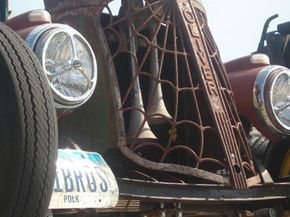Putting Together a Rat Rod
Putting together a rat rod is a little different than restoring a classic car. With a restoration project, you're either installing original parts or replicas. Some of those parts might even come with instructions. Not so with rat rods. You will probably not be able to find an Internet FAQ that explains how to weld a 1929 Dodge body onto a 1952 Chevy pickup frame. You may find yourself combining parts that have never been combined in the history of the automobile. So you'd best know how to do some fabrication and welding or at least know someone who does. Bruce Oliver relied on his older brother's welding skills. "Without him, my rat rod would not have been possible."
A lot of mechanical skill and knowledge of car repair is vital. And it's important to remember that your rat rod will not be not showroom perfect, and it sure as heck won't be under warranty. Parts will break and you'll need to fix them yourself. Hopefully you won't have to fix them on the side of the road when you're far from home. Before you ever head out onto the open road, you'll likely have to rebuild a lot of older mechanical parts on your rat rod, too, such as the starter, alternator, carburetor or even the entire engine just to name a few.
Advertisement
But perhaps even more important than basic mechanical knowledge is the ability to improvise, solve problems and be creative. This is yet another factor that makes rat rods appealing -- they display the creative mechanical efforts of their owners. Very rarely does a part just fit into place. Oliver said, "In some ways a rat rod is a work of art if you take the time to look at the fine details involved in building them." He also said the owners "usually have some very ingenious methods to do things."
Let's say, for example, you rebuild an old engine to drop into your rat rod. It's obviously not an engine designed to fit that particular car, so you need to make your own engine mounts. You'll have to carefully measure the mounting points so the engine will link up to the transmission properly. Then you'll have to figure out how to connect the transmission to the junkyard rear-end assembly you found. As you can see, problem-solving skills are a necessity for rat rodders.
Building a cool, loud, beat-up car sounds great, but are these things legal? We'll find out in the next section.
